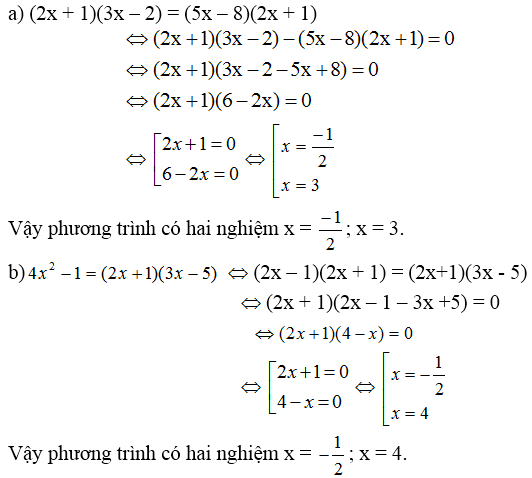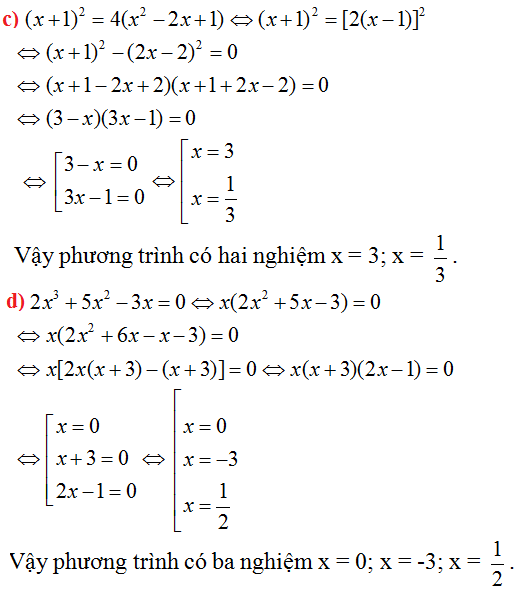Giải phương trình: \(\left(2x-1\right)^2-2\left|2x-1\right|-5=0\).

Những câu hỏi liên quan
Giải các phương trình sau:1, dfrac{x-1}{3}-xdfrac{2x-4}{4}2, left(x-2right)left(2x-1right)x^2-2x3, 3x^2-4x+104, left|2x-4right|05, left|3x+2right|46, left|2x-5right|left|-x+2right|*Giúp mình với mình đg cần gấp ạ T_T
Đọc tiếp
Giải các phương trình sau:
1, \(\dfrac{x-1}{3}-x=\dfrac{2x-4}{4}\)
2, \(\left(x-2\right)\left(2x-1\right)=x^2-2x\)
3, \(3x^2-4x+1=0\)
4, \(\left|2x-4\right|=0\)
5, \(\left|3x+2\right|=4\)
6, \(\left|2x-5\right|=\left|-x+2\right|\)
*Giúp mình với mình đg cần gấp ạ T_T
\(1.\dfrac{x-1}{3}-x=\dfrac{2x-4}{4}.\Leftrightarrow\dfrac{x-1-3x}{3}=\dfrac{x-2}{2}.\Leftrightarrow\dfrac{-2x-1}{3}-\dfrac{x-2}{2}=0.\)
\(\Leftrightarrow\dfrac{-4x-2-3x+6}{6}=0.\Rightarrow-7x+4=0.\Leftrightarrow x=\dfrac{4}{7}.\)
\(2.\left(x-2\right)\left(2x-1\right)=x^2-2x.\Leftrightarrow\left(x-2\right)\left(2x-1\right)-x\left(x-2\right)=0.\)
\(\Leftrightarrow\left(x-2\right)\left(2x-1-x\right)=0.\Leftrightarrow\left(x-2\right)\left(x-1\right)=0.\)
\(\Leftrightarrow\left[{}\begin{matrix}x=2.\\x=1.\end{matrix}\right.\)
\(3.3x^2-4x+1=0.\Leftrightarrow\left(x-1\right)\left(x-\dfrac{1}{3}\right)=0.\Leftrightarrow\left[{}\begin{matrix}x=1.\\x=\dfrac{1}{3}.\end{matrix}\right.\)
\(4.\left|2x-4\right|=0.\Leftrightarrow2x-4=0.\Leftrightarrow x=2.\)
\(5.\left|3x+2\right|=4.\Leftrightarrow\left[{}\begin{matrix}3x+2=4.\\3x+2=-4.\end{matrix}\right.\Leftrightarrow\left[{}\begin{matrix}x=\dfrac{2}{3}.\\x=-2.\end{matrix}\right.\)
Đúng 1
Bình luận (2)
\(1,\dfrac{x-1}{3}-x=\dfrac{2x-4}{4}\\ \Leftrightarrow\dfrac{x-1}{3}-x=\dfrac{x-2}{2}\\ \Leftrightarrow\dfrac{2\left(x-1\right)-6x}{6}=\dfrac{3\left(x-2\right)}{6}\\ \Leftrightarrow2\left(x-1\right)-6x=3\left(x-2\right)\\ \Leftrightarrow2x-2-6x=3x-6\\ \Leftrightarrow-4x-2=3x-6\)
\(\Leftrightarrow3x-6+4x+2=0\\ \Leftrightarrow7x-4=0\\ \Leftrightarrow x=\dfrac{4}{7}\)
\(2,\left(x-2\right)\left(2x-1\right)=x^2-2x\\ \Leftrightarrow2x^2-4x-x+2=x^2-2x\\ \Leftrightarrow x^2-3x+2=0\\ \Leftrightarrow\left(x^2-2x\right)-\left(x-2\right)=0\\ \Leftrightarrow x\left(x-2\right)-\left(x-2\right)=0\\ \Leftrightarrow\left(x-1\right)\left(x-2\right)=0\\ \Leftrightarrow\left[{}\begin{matrix}x=1\\x=2\end{matrix}\right.\)
\(3,3x^2-4x+1=0\\ \Leftrightarrow\left(3x^2-3x\right)-\left(x-1\right)=0\\ \Leftrightarrow3x\left(x-1\right)-\left(x-1\right)=0\\ \Leftrightarrow\left(x-1\right)\left(3x-1\right)=0\\ \Leftrightarrow\left[{}\begin{matrix}x=1\\x=\dfrac{1}{3}\end{matrix}\right.\)
\(4,\left|2x-4\right|=0\\ \Leftrightarrow2x-4=0\\ \Leftrightarrow2x=4\\ \Leftrightarrow x=2\)
\(5,\left|3x+2\right|=4\\ \Leftrightarrow\left[{}\begin{matrix}3x+2=4\\3x+2=-4\end{matrix}\right.\\ \Leftrightarrow\left[{}\begin{matrix}3x=2\\3x=-6\end{matrix}\right.\\ \Leftrightarrow\left[{}\begin{matrix}x=\dfrac{2}{3}\\x=-2\end{matrix}\right.\)
\(6,\left|2x-5\right|=\left|-x+2\right|\\ \Leftrightarrow\left[{}\begin{matrix}2x-5=-x+2\\2x-5=x-2\end{matrix}\right.\\ \Leftrightarrow\left[{}\begin{matrix}3x=7\\x=3\end{matrix}\right.\\ \Leftrightarrow\left[{}\begin{matrix}x=\dfrac{7}{3}\\x=3\end{matrix}\right.\)
Đúng 0
Bình luận (0)
Bài 1. Giải các bất phương trình sau 1) dfrac{2x-1}{x+1}-2 0 2) dfrac{x^2-2x+5}{x-2}-x+1ge03) dfrac{left(1+2xright)left(x-3right)}{left(2x+3right)left(1-xright)}le0 4) left|2x-3right|5 5)left|1-2xright|le46) left|3x+1right|x-2
Đọc tiếp
Bài 1. Giải các bất phương trình sau 1) \(\dfrac{2x-1}{x+1}-2< 0\) 2) \(\dfrac{x^2-2x+5}{x-2}-x+1\ge0\)
3) \(\dfrac{\left(1+2x\right)\left(x-3\right)}{\left(2x+3\right)\left(1-x\right)}\le0\) 4) \(\left|2x-3\right|>5\) 5)\(\left|1-2x\right|\le4\)
6) \(\left|3x+1\right|>x-2\)
\(\dfrac{2x-1}{x+1}-2< 0.\left(x\ne-1\right).\\ \Leftrightarrow\dfrac{2x-1-2x-2}{x+1}< 0.\Leftrightarrow\dfrac{-3}{x+1}< 0.\)
Mà \(-3< 0.\)
\(\Rightarrow x+1>0.\Leftrightarrow x>-1\left(TMĐK\right).\)
\(\dfrac{x^2-2x+5}{x-2}-x+1\ge0.\left(x\ne2\right).\\ \Leftrightarrow\dfrac{x^2-2x+5-x^2+2x+x-2}{x-2}\ge0.\\ \Leftrightarrow\dfrac{x+3}{x-2}\ge0.\)
\(\Leftrightarrow\left[{}\begin{matrix}\left\{{}\begin{matrix}x+3\ge0.\\x-2\ge0.\end{matrix}\right.\\\left\{{}\begin{matrix}x+3\le0.\\x-2\le0.\end{matrix}\right.\end{matrix}\right.\) \(\Leftrightarrow\left[{}\begin{matrix}\left\{{}\begin{matrix}x\ge-3.\\x\ge2.\end{matrix}\right.\\\left\{{}\begin{matrix}x\le-3.\\x\le2.\end{matrix}\right.\end{matrix}\right.\) \(\Leftrightarrow\left[{}\begin{matrix}x\ge2.\\x\le-3.\end{matrix}\right.\)
Kết hợp ĐKXĐ.
\(\Rightarrow\left[{}\begin{matrix}x>2.\\x\le-3.\end{matrix}\right.\)
\(\dfrac{\left(1+2x\right)\left(x-2\right)}{\left(2x+3\right)\left(1-x\right)}\le0.\left(x\ne1;x\ne\dfrac{-3}{2}\right).\)
Đặt \(\dfrac{\left(1+2x\right)\left(x-2\right)}{\left(2x+3\right)\left(1-x\right)}=f\left(x\right).\)
Ta có bảng sau:
| \(x\) | \(-\infty\) \(-\dfrac{3}{2}\) \(-\dfrac{1}{2}\) \(1\) \(2\) \(+\infty\) |
| \(1+2x\) | - | - 0 + | + | + |
| \(x-2\) | - | - | - | - 0 + |
| \(2x+3\) | - 0 + | + | + | + |
| \(1-x\) | + | + | + 0 - | - |
| \(f\left(x\right)\) | - || + 0 - || + 0 - |
Vậy \(f\left(x\right)\ge0.\Leftrightarrow x\in\left(\dfrac{-3}{2};\dfrac{-1}{2}\right)\cup\)(1;2].
Đúng 1
Bình luận (0)
Bài tập. Giải các phương trình sau:
a) \(\left|7-x\right|+2x=3\)
b) \(\left|2x-3\right|-4x-9=0\)
c) \(\left|3x+5\right|=\left|2-5x\right|\)
d) \(x\left|x-3\right|-\left|x^2+x+1\right|=1\)
a: =>|x-7|=3-2x
\(\Leftrightarrow\left\{{}\begin{matrix}x< =\dfrac{3}{2}\\\left(-2x+3\right)^2-\left(x-7\right)^2=0\end{matrix}\right.\)
\(\Leftrightarrow\left\{{}\begin{matrix}x< =\dfrac{3}{2}\\\left(2x-3-x+7\right)\left(2x-3+x-7\right)=0\end{matrix}\right.\)
\(\Leftrightarrow\left\{{}\begin{matrix}x< =\dfrac{3}{2}\\\left(x+4\right)\left(3x-10\right)=0\end{matrix}\right.\Leftrightarrow x=-4\)
b: =>|2x-3|=4x+9
\(\Leftrightarrow\left\{{}\begin{matrix}x>=-\dfrac{9}{4}\\\left(4x+9-2x+3\right)\left(4x+9+2x-3\right)=0\end{matrix}\right.\)
\(\Leftrightarrow\left\{{}\begin{matrix}x>=-\dfrac{9}{4}\\\left(2x+12\right)\left(6x+6\right)=0\end{matrix}\right.\Leftrightarrow x=-1\)
c: =>3x+5=2-5x hoặc 3x+5=5x-2
=>8x=-3 hoặc -2x=-7
=>x=-3/8 hoặc x=7/2
Đúng 5
Bình luận (0)
Giải các phương trình sau bằng cách đưa về phương trình tích :
a) \(\left(2x+1\right)\left(3x-2\right)=\left(5x-8\right)\left(2x+1\right)\)
b) \(4x^2-1=\left(2x+1\right)\left(3x-5\right)\)
c) \(\left(x+1\right)^2=4\left(x^2-2x+1\right)\)
d) \(2x^3+5x^2-3x=0\)
a)(2x+1)(3x-2)=(5x-8)(2x+1)
⇔(2x+1)(3x-2)-(5x-8)(2x+1)=0
⇔(2x+1)(3x-2-5x+8)=0
⇔(2x+1)(-2x+6)=0
⇔2x+1=0 hoặc -2x+6=0
1.2x+1=0⇔2x=-1⇔x=-1/2
2.-2x+6=0⇔-2x=-6⇔x=3
phương trình có 2 nghiệm x=-1/2 và x=3
Đúng 0
Bình luận (0)
b)4x2-1=(2x+1)(3x-5)
⇔(2x-1)(2x+1)-(2x+1)(3x-5)=0
⇔(2x+1)(2x-1-3x+5)=0
⇔(2x+1)(-x+4)=0
⇔2x+1=0 hoặc -x+4=0
1.2x+1=0⇔2x=-1⇔x=-1/2
2.-x+4=0⇔-x=-4⇔x=4
phương trình có 2 nghiệm x=-1/2 và x=4
Đúng 0
Bình luận (0)
Giải phương trình
\(\left|2x+1\right|\)=\(\left|3x+5\right|\)
\(\left|2x-1\right|\)=\(\left|-5x-2\right|\)
`|2x+1|=|3x+5|`
`<=> [(2x+1=3x+5),(2x+1=-(3x+5):}`
`<=> [(x=-4),(x=-6/5):}`
.
`|2x-1|=|-5x-2|`
`<=> [(2x-1=-5x-2),(2x-1=-(-5x-2):}`
`<=> [(x=-1/7),(x=-1):}`
Đúng 3
Bình luận (1)
Tìm x biết :
\(\sqrt{\left(2x-1\right)}^2=5\)
gợi ý:
\(\sqrt{\left(2x-1\right)}^2=\left|2x-1\right|\)
cần giải hai phương trình
2x-1=5
2x-1=-5
\(\Leftrightarrow\left|2x-1\right|=5\Leftrightarrow\left[{}\begin{matrix}2x-1=5\\1-2x=5\end{matrix}\right.\Leftrightarrow\left[{}\begin{matrix}x=3\\x=-2\end{matrix}\right.\)
Đúng 1
Bình luận (0)
Giải các phương trình bằng cách đưa về phương trình tích:
a) \(\left(3x^2-7x-10\right)\left[2x^2+\left(1-\sqrt{5}\right)x+\sqrt{5}-3\right]=0;\)
b) \(x^3+3x^2-2x-6=0;\)
c) \(\left(x^2-1\right)\left(0,6x+1\right)=0,6x^2+x;\)
d) \(\left(x^2+2x-5\right)^2=\left(x^2-x+5\right)^2.\)
a) (3x2 - 7x – 10)[2x2 + (1 - √5)x + √5 – 3] = 0
=> hoặc (3x2 - 7x – 10) = 0 (1)
hoặc 2x2 + (1 - √5)x + √5 – 3 = 0 (2)
Giải (1): phương trình a - b + c = 3 + 7 - 10 = 0
nên
x1 = - 1, x2 = =
Giải (2): phương trình có a + b + c = 2 + (1 - √5) + √5 - 3 = 0
nên
x3 = 1, x4 =
b) x3 + 3x2– 2x – 6 = 0 ⇔ x2(x + 3) – 2(x + 3) = 0 ⇔ (x + 3)(x2 - 2) = 0
=> hoặc x + 3 = 0
hoặc x2 - 2 = 0
Giải ra x1 = -3, x2 = -√2, x3 = √2
c) (x2 - 1)(0,6x + 1) = 0,6x2 + x ⇔ (0,6x + 1)(x2 – x – 1) = 0
=> hoặc 0,6x + 1 = 0 (1)
hoặc x2 – x – 1 = 0 (2)
(1) ⇔ 0,6x + 1 = 0
⇔ x2 = =
(2): ∆ = (-1)2 – 4 . 1 . (-1) = 1 + 4 = 5, √∆ = √5
x3 = , x4 =
Vậy phương trình có ba nghiệm:
x1 = , x2 =
, x3 =
,
d) (x2 + 2x – 5)2 = ( x2 – x + 5)2 ⇔ (x2 + 2x – 5)2 - ( x2 – x + 5)2 = 0
⇔ (x2 + 2x – 5 + x2 – x + 5)( x2 + 2x – 5 - x2 + x - 5) = 0
⇔ (2x2 + x)(3x – 10) = 0
⇔ x(2x + 1)(3x – 10) = 0
Hoặc x = 0, x = , x =
Vậy phương trình có 3 nghiệm:
x1 = 0, x2 = , x3 =
Đúng 0
Bình luận (0)
1. giải phương trình tích:a) left(x+3right)left(x^2+2021right)02. giải các phương trình sau bằng cách đưa về phương trình tích:b) xleft(x-3right)+3left(x-3right)0c) left(x^2-9right)+left(x+3right)left(3-2xright)0d) 3x^2+3x0e) x^2-4x+44
Đọc tiếp
1. giải phương trình tích:
a) \(\left(x+3\right)\left(x^2+2021\right)=0\)
\(\)2. giải các phương trình sau bằng cách đưa về phương trình tích:
b) \(x\left(x-3\right)+3\left(x-3\right)=0\)
c) \(\left(x^2-9\right)+\left(x+3\right)\left(3-2x\right)=0\)
d) \(3x^2+3x=0\)
e) \(x^2-4x+4=4\)
`a,(x+3)(x^2+2021)=0`
`x^2+2021>=2021>0`
`=>x+3=0`
`=>x=-3`
`2,x(x-3)+3(x-3)=0`
`=>(x-3)(x+3)=0`
`=>x=+-3`
`b,x^2-9+(x+3)(3-2x)=0`
`=>(x-3)(x+3)+(x+3)(3-2x)=0`
`=>(x+3)(-x)=0`
`=>` $\left[ \begin{array}{l}x=0\\x=-3\end{array} \right.$
`d,3x^2+3x=0`
`=>3x(x+1)=0`
`=>` $\left[ \begin{array}{l}x=0\\x=-1\end{array} \right.$
`e,x^2-4x+4=4`
`=>x^2-4x=0`
`=>x(x-4)=0`
`=>` $\left[ \begin{array}{l}x=0\\x=4\end{array} \right.$
Đúng 2
Bình luận (0)
1) a) \(\left(x+3\right).\left(x^2+2021\right)=0\\ \Leftrightarrow\left[{}\begin{matrix}x+3=0\\x^2+2021=0\end{matrix}\right.\\\left[{}\begin{matrix}x=-3\left(nhận\right)\\x^2=-2021\left(loại\right)\end{matrix}\right. \)
=> S={-3}
Đúng 2
Bình luận (0)
Bài 1:
a) Ta có: \(\left(x+3\right)\left(x^2+2021\right)=0\)
mà \(x^2+2021>0\forall x\)
nên x+3=0
hay x=-3
Vậy: S={-3}
Bài 2:
b) Ta có: \(x\left(x-3\right)+3\left(x-3\right)=0\)
\(\Leftrightarrow\left(x-3\right)\left(x+3\right)=0\)
\(\Leftrightarrow\left[{}\begin{matrix}x-3=0\\x+3=0\end{matrix}\right.\Leftrightarrow\left[{}\begin{matrix}x=3\\x=-3\end{matrix}\right.\)
Vậy: S={3;-3}
Đúng 1
Bình luận (0)
giải hệ phương trình \(\left\{{}\begin{matrix}2x\left(x-1\right)+\left(y-1\right)\left(2y+1\right)=0\\2y^2+2x+y+1=6xy\end{matrix}\right.\)
\(\Leftrightarrow\left\{{}\begin{matrix}2x^2-2x+2y^2-y-1=0\\2y^2+2x+y+1-6xy=0\end{matrix}\right.\)
Cộng vế với vế:
\(2x^2+4y^2-6xy=0\)
\(\Leftrightarrow\left(x-y\right)\left(x-2y\right)=0\)
Thế vào 1 trong 2 pt ban đầu
Đúng 0
Bình luận (0)




























